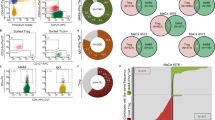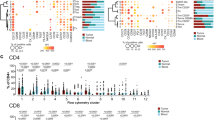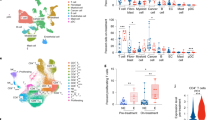Abstract
The quantity of tumor-infiltrating lymphocytes (TILs) in breast cancer (BC) is a robust prognostic factor for improved patient survival, particularly in triple-negative and HER2-overexpressing BC subtypes1. Although T cells are the predominant TIL population2, the relationship between quantitative and qualitative differences in T cell subpopulations and patient prognosis remains unknown. We performed single-cell RNA sequencing (scRNA-seq) of 6,311 T cells isolated from human BCs and show that significant heterogeneity exists in the infiltrating T cell population. We demonstrate that BCs with a high number of TILs contained CD8+ T cells with features of tissue-resident memory T (TRM) cell differentiation and that these CD8+ TRM cells expressed high levels of immune checkpoint molecules and effector proteins. A CD8+ TRM gene signature developed from the scRNA-seq data was significantly associated with improved patient survival in early-stage triple-negative breast cancer (TNBC) and provided better prognostication than CD8 expression alone. Our data suggest that CD8+ TRM cells contribute to BC immunosurveillance and are the key targets of modulation by immune checkpoint inhibition. Further understanding of the development, maintenance and regulation of TRM cells will be crucial for successful immunotherapeutic development in BC.
This is a preview of subscription content, access via your institution
Access options
Access Nature and 54 other Nature Portfolio journals
Get Nature+, our best-value online-access subscription
$29.99 / 30 days
cancel any time
Subscribe to this journal
Receive 12 print issues and online access
$209.00 per year
only $17.42 per issue
Buy this article
- Purchase on Springer Link
- Instant access to full article PDF
Prices may be subject to local taxes which are calculated during checkout




Similar content being viewed by others
Change history
22 August 2018
In the version of this article originally published, the institution in affiliation 10 was missing. Affiliation 10 was originally listed as Department of Surgery, Royal Melbourne Hospital and Royal Womens’ Hospital, Melbourne, Victoria, Australia. It should have been Department of Surgery, Royal Melbourne Hospital and Royal Womens’ Hospital, University of Melbourne, Melbourne, Victoria, Australia. The error has been corrected in the HTML and PDF versions of this article.
References
Savas, P. et al. Clinical relevance of host immunity in breast cancer: from TILs to the clinic. Nat. Rev. Clin. Oncol. 13, 228–241 (2016).
Ruffell, B. et al. Leukocyte composition of human breast cancer. Proc. Natl Acad. Sci. USA 109, 2796–2801 (2012).
Adams, S. et al. Phase 2 study of pembrolizumab (pembro) monotherapy for previously treated metastatic triple-negative breast cancer (mTNBC): KEYNOTE-086 cohort A. J. Clin. Oncol. 35 no. 15_suppl, 1008 (2017).
Schmid, P. et al. Atezolizumab in metastatic TNBC (mTNBC): long-term clinical outcomes and biomarker analyses. Cancer Res. 77, 2986 (2017).
Loi, S. et al. Relationship between tumor infiltrating lymphocyte (TIL) levels and response to pembrolizumab (pembro) in metastatic triple-negative breast cancer (mTNBC): results from KEYNOTE-086. Ann. Oncol. 28, LBA13 (2017).
Loi, S.et al. Pooled individual patient data analysis of stromal tumor infiltrating lymphocytes in primary triple negative breast cancer treated with anthracycline-based chemotherapy. Cancer Res. 76, abstr. S1–03 (2015).
Nolan, E. et al. Combined immune checkpoint blockade as a therapeutic strategy for BRCA1-mutated breast cancer. Sci. Transl. Med. 9, eaal4922 (2017).
Gu-Trantien, C. et al. CD4+ follicular helper T cell infiltration predicts breast cancer survival. J. Clin. Invest. 123, 2873–2892 (2013).
Plitas, G. et al. Regulatory T cells exhibit distinct features in human breast cancer. Immunity 45, 1122–1134 (2016).
Hombrink, P. et al. Programs for the persistence, vigilance and control of human CD8+ lung-resident memory T cells. Nat. Immunol. 17, 1467–1478 (2016).
Kumar, B. V. et al. Human tissue-resident memory t cells are defined by core transcriptional and functional signatures in lymphoid and mucosal sites. Cell Reports 20, 2921–2934 (2017).
Mackay, L. K. et al. The developmental pathway for CD103(+)CD8+ tissue-resident memory T cells of skin. Nat. Immunol. 14, 1294–1301 (2016).
Schenkel, J. M. & Masopust, D. Tissue-resident memory T cells. Immunity 41, 886–897 (2014).
Trapnell, C. et al. The dynamics and regulators of cell fate decisions are revealed by pseudotemporal ordering of single cells. Nat. Biotechnol. 32, 381–386 (2014).
Mueller, S. N. & Mackay, L. K. Tissue-resident memory T cells: local specialists in immune defence. Nat. Rev. Immunol. 16, 79–89 (2016).
Malik, B. T. et al. Resident memory T cells in the skin mediate durable immunity to melanoma. Sci. Immunol. 2, eaam6346 (2017).
Nizard, M. et al. Induction of resident memory T cells enhances the efficacy of cancer vaccine. Nat. Commun. 8, 15221 (2017).
Ganesan, A. P. et al. Tissue-resident memory features are linked to the magnitude of cytotoxic T cell responses in human lung cancer. Nat. Immunol. 18, 940–950 (2017).
Thompson, E. D., Enriquez, H. L., Fu, Y. X. & Engelhard, V. H. Tumor masses support naive T cell infiltration, activation, and differentiation into effectors. J. Exp. Med. 207, 1791–1804 (2010).
Riaz, N. et al. Tumor and microenvironment evolution during immunotherapy with nivolumab. Cell 171, 934–949.e915 (2017).
Tumeh, P. C. et al. PD-1 blockade induces responses by inhibiting adaptive immune resistance. Nature 515, 568–571 (2014).
Desmedt, C. et al. Biological processes associated with breast cancer clinical outcome depend on the molecular subtypes. Clinical Cancer Res. 14, 5158–5165 (2008).
Teschendorff, A. E., Miremadi, A., Pinder, S. E., Ellis, I. O. & Caldas, C. An immune response gene expression module identifies a good prognosis subtype in estrogen receptor negative breast cancer. Genome Biol. 8, R157 (2007).
Denkert, C. et al. Tumor-associated lymphocytes as an independent predictor of response to neoadjuvant chemotherapy in breast cancer. J. Clin. Oncol. 28, 105–113 (2010).
Loi, S. et al. Tumor infiltrating lymphocytes (TILs) indicate trastuzumab benefit in early-stage HER2-positive breast cancer (HER2+ BC). Cancer Res. 73, abstr. S1–05 (2013).
Loi, S. et al. Tumor infiltrating lymphocytes are prognostic in triple negative breast cancer and predictive for trastuzumab benefit in early breast cancer: results from the FinHER trial. Ann. Oncol. 25, 1544–1550 (2014).
Luen, S. J. et al. Tumour-infiltrating lymphocytes in advanced HER2-positive breast cancer treated with pertuzumab or placebo in addition to trastuzumab and docetaxel: a retrospective analysis of the CLEOPATRA study. Lancet Oncol. 18, 52–62 (2017).
Salgado, R. et al. Tumor-infiltrating lymphocytes and associations with pathological complete response and event-free survival in HER2-positive early-stage breast cancer treated with lapatinib and trastuzumab: a secondary analysis of the NeoALTTO trial. JAMA Oncol 1, 448–454 (2015).
Ali, H. R. et al. Association between CD8+ T-cell infiltration and breast cancer survival in 12,439 patients. Ann. Oncol 25, 1536–1543 (2014).
DeNardo, D. G. & Coussens, L. M. Inflammation and breast cancer. Balancing immune response: crosstalk between adaptive and innate immune cells during breast cancer progression. BCR 9, 212 (2007).
Topalian, S. L., Muul, L. M., Solomon, D. & Rosenberg, S. A. Expansion of human tumor infiltrating lymphocytes for use in immunotherapy trials. J. Immunol. Methods 102, 127–141 (1987).
Stack, E. C., Wang, C., Roman, K. A. & Hoyt, C. C. Multiplexed immunohistochemistry, imaging, and quantitation: a review, with an assessment of Tyramide signal amplification, multispectral imaging and multiplex analysis. Methods 70, 46–58 (2014).
Jiang, H., Lei, R., Ding, S. W. & Zhu, S. Skewer: a fast and accurate adapter trimmer for next-generation sequencing paired-end reads. BMC Bioinformatics 15, 182 (2014).
Bray, N. L., Pimentel, H., Melsted, P. & Pachter, L. Near-optimal probabilistic RNA-seq quantification. Nat. Biotechnol. 34, 525–527 (2016).
Soneson, C., Love, M. I. & Robinson, M. D. Differential analyses for RNA-seq: transcript-level estimates improve gene-level inferences. F1000Res 4, 1521 (2015).
Ritchie, M. E. et al. limma powers differential expression analyses for RNA-sequencing and microarray studies. Nucleic Acids Res. 43, e47 (2015).
Law, C. W., Chen, Y., Shi, W. & Smyth, G. K. voom: Precision weights unlock linear model analysis tools for RNA-seq read counts. Genome Biol. 15, R29 (2014).
Liu, R. et al. Why weight? Modelling sample and observational level variability improves power in RNA-seq analyses. Nucleic Acids Res. 43, e97 (2015).
Bolotin, D. A. et al. MiXCR: software for comprehensive adaptive immunity profiling. Nat. Methods 12, 380–381 (2015).
Bolotin, D. A. et al. Antigen receptor repertoire profiling from RNA-seq data. Nat. Biotechnol. 35, 908–911 (2017).
Macosko, E. Z. et al. Highly parallel genome-wide expression profiling of individual cells using nanoliter droplets. Cell 161, 1202–1214 (2015).
Risso, D., Perraudeau, F., Gribkova, S., Dudoit, S. & Vert, J.-P. ZINB-WaVE: a general and flexible method for signal extraction from single-cell RNA-seq data. Preprint at https://doi.org/10.1101/125112 (2017).
Huang, M. et al. SAVER: Gene expression recovery for UMI-based single cell RNA sequencing. Preprint at https://doi.org/10.1101/138677 (2017).
Ye, C., Speed, T.P. & Salim, A. DECENT: differential expression with capture efficiency adjustment for single-cell RNA-seq data. Preprint at https://doi.org/10.1101/225177 (2017).
Wu, D. & Smyth, G. K. Camera: a competitive gene set test accounting for inter-gene correlation. Nucleic Acids Res. 40, e133 (2012).
Scialdone, A. et al. Computational assignment of cell-cycle stage from single-cell transcriptome data. Methods 85, 54–61 (2015).
Lun, A. T., McCarthy, D. J. & Marioni, J. C. A step-by-step workflow for low-level analysis of single-cell RNA-seq data with Bioconductor. F1000Res 5, 2122 (2016).
Qiu, X. et al. Reversed graph embedding resolves complex single-cell trajectories. Nat. Methods 14, 979–982 (2017).
Curtis, C. et al. The genomic and transcriptomic architecture of 2,000 breast tumours reveals novel subgroups. Nature 486, 346–352 (2012).
Gao, J. et al. Integrative analysis of complex cancer genomics and clinical profiles using the cBioPortal. Sci. Signal. 6, pl1 (2013).
Perou, C. M. et al. Molecular portraits of human breast tumours. Nature 406, 747–752 (2000).
McCarthy, D. J., Chen, Y. & Smyth, G. K. Differential expression analysis of multifactor RNA-Seq experiments with respect to biological variation. Nucleic Acids Res 40, 4288–4297 (2012).
Robinson, M. D., McCarthy, D. J. & Smyth, G. K. edgeR: a Bioconductor package for differential expression analysis of digital gene expression data. Bioinformatics 26, 139–140 (2010).
Smyth, G. K., Michaud, J. & Scott, H. S. Use of within-array replicate spots for assessing differential expression in microarray experiments. Bioinformatics 21, 2067–2075 (2005).
Wu, D. et al. ROAST: rotation gene set tests for complex microarray experiments. Bioinformatics 26, 2176–2182 (2010).
Bonett, D. G. & Wright, T. A. Sample size requirements for estimating pearson, kendall and spearman correlations. Psychometrika 65, 23–28 (2000).
Bishara, A. J. & Hittner, J. B. Confidence intervals for correlations when data are not normal. Behav. Res. Methods 49, 294–309 (2017).
Acknowledgements
We wish to thank H. Thorne, E. Niedermayr, all the kConFab research nurses and staff, the heads and staff of the Family Cancer Clinics and the Clinical Follow Up Study (which has received funding from the National Health and Medical Research Council of Australia (NHMRC), the National Breast Cancer Foundation (NBCF), Cancer Australia and the National Institute of Health (United States) for their contributions to this research, and the many families who contribute to kConFab. We wish to thank the FACS core facility staff R. Rossi, V. Milovac and S. Curcio, and T. Tan and P. Petrone for additional FACS assistance. We also thank S. Ellis for assistance with confocal imaging, G. M. Arnau for facilitating RNA-seq, and the Anatomical Pathology staff at the Peter MacCallum Cancer Centre. Special thanks also to J. Jabbari and the Australian Genome Research Facility for making the single-cell sequencing possible.
This study was funded by the Breast Cancer Research Foundation (BCRF), NY. S.L. is supported by the Cancer Council Victoria John Colebatch Fellowship and the National Breast Cancer Foundation. P.S. is supported by the NHMRC and the NBCF (Post Graduate Scholarship 1094388), the Cancer Therapeutics CRC and the Peter Mac Foundation. Z.L.T. is supported by the NHMRC (Early Career Fellowship 1106967). D.G. is supported by the Peter Mac Foundation. P.A.B. is supported by the NHMRC (Early Career Fellowship 17-005). S.J.L is supported by the University of Melbourne. S.B.F. is supported by the NHMRC (Practitioner Fellowship 1079329). kConFab is supported by a grant from NBCF, and previously NHMRC, the Queensland Cancer Fund, the Cancer Councils of New South Wales, Victoria, Tasmania and South Australia, and the Cancer Foundation of Western Australia. P.K.D is supported by the NHMRC (Senior Research Fellowship 1136680 and Program Grant 1132373). T.S. is supported by the NHMRC (Program Grant 1054618). P.J.N. is supported by the NHMRC (Program Grant 1132373).
Author information
Authors and Affiliations
Consortia
Contributions
P.S. conceived and designed the study, provided and collected study materials and samples and patient data, performed experiments, analyzed data and wrote the manuscript. B.V. designed the study, provided and collected study materials and samples and patient data, performed experiments, analyzed data and wrote the manuscript. C.Y. developed analysis methods and software, analyzed data and wrote the manuscript. A.S. developed analysis methods and software, analyzed single-cell sequencing data and wrote the manuscript. C.P.M performed experiments, analyzed data and wrote the manuscript. F.C. analyzed data and wrote the manuscript. R.S. analyzed data and wrote the manuscript. D.J.B performed experiments and wrote the manuscript. Z.L.T. provided and collected study materials and samples, analyzed data and wrote the manuscript. S.D. performed experiments, analyzed data and wrote the manuscript. A.B. performed experiments, analyzed data and wrote the manuscript. L.W. provided and collected study materials and samples and patient data and wrote the manuscript. S.J.L. provided and collected study materials and samples and patient data and wrote the manuscript. C.P. provided and collected study materials and samples and patient data. S.S.N. provided and collected study materials and samples and patient data. A.S.S. provided and collected study materials and samples and patient data. D.E.G. provided and collected study materials and samples and patient data. C.M.T. provided and collected study materials and samples and patient data. P.A.B. analyzed data and wrote the manuscript. S.B.F provided and collected study materials and samples and patient data, analyzed data and wrote the manuscript. kConFab provided and collected study materials and samples. P.K.D. designed the study, analyzed data and wrote the manuscript. T.P.S. developed analysis methods and software, designed the study and wrote the manuscript. L.K.M. designed the study and wrote the manuscript. P.J.N. designed the study and wrote the manuscript. S.L. conceived and designed the study, provided and collected study materials and samples and patient data and wrote the manuscript.
Corresponding authors
Ethics declarations
Competing interests
The authors declare no competing interests.
Additional information
Publisher’s note: Springer Nature remains neutral with regard to jurisdictional claims in published maps and institutional affiliations.
Supplementary information
Supplementary Text and and Table
Supplementary Figures 1–15 and Supplementary Table 1
Supplementary Table 2
CD8 TRM signatures derived from single-cell sequencing.
Supplementary Table 3
Differential expression between all clusters in single-cell sequencing.
Supplementary Table 4
Differential expression between flow sorted CD8+CD69+CD103+ and CD8+CD69+CD103 T cells from 2 primary breast (TNBC and HER2) cancers and 1 liver metastasis (TNBC) from 3 different patients.
Rights and permissions
About this article
Cite this article
Savas, P., Virassamy, B., Ye, C. et al. Single-cell profiling of breast cancer T cells reveals a tissue-resident memory subset associated with improved prognosis. Nat Med 24, 986–993 (2018). https://doi.org/10.1038/s41591-018-0078-7
Received:
Accepted:
Published:
Issue Date:
DOI: https://doi.org/10.1038/s41591-018-0078-7
This article is cited by
-
T-cell infiltration and its regulatory mechanisms in cancers: insights at single-cell resolution
Journal of Experimental & Clinical Cancer Research (2024)
-
Tumor microenvironment and immune system preservation in early-stage breast cancer: routes for early recurrence after mastectomy and treatment for lobular and ductal forms of disease
BMC Immunology (2024)
-
Single-cell RNA sequencing of anaplastic ependymoma and H3K27M-mutant diffuse midline glioma
BMC Neurology (2024)
-
Decoding the transcriptional heterogeneity, differentiation lineage, clinical significance in tissue-resident memory CD8 T cell of the small intestine by single-cell analysis
Journal of Translational Medicine (2024)
-
CD8+ T cell priming that is required for curative intratumorally anchored anti-4-1BB immunotherapy is constrained by Tregs
Nature Communications (2024)



